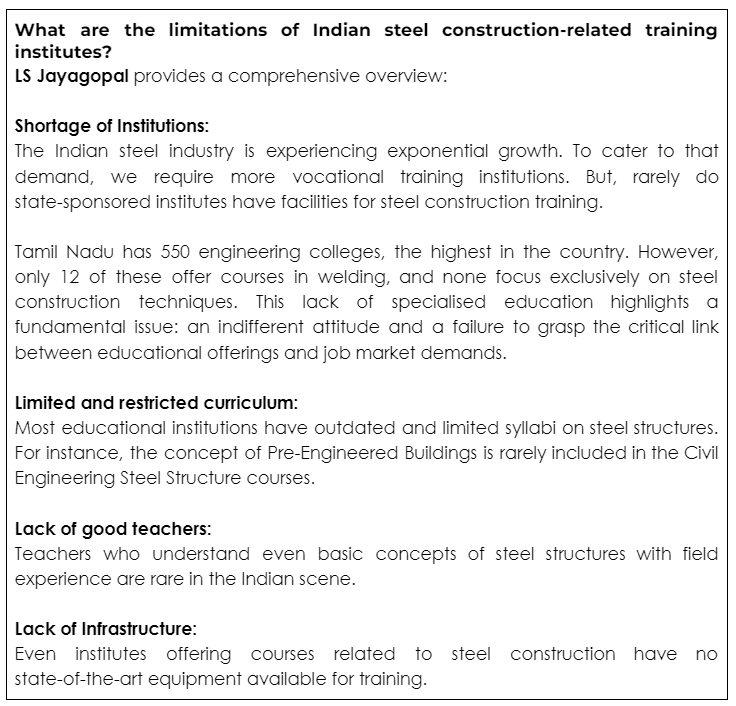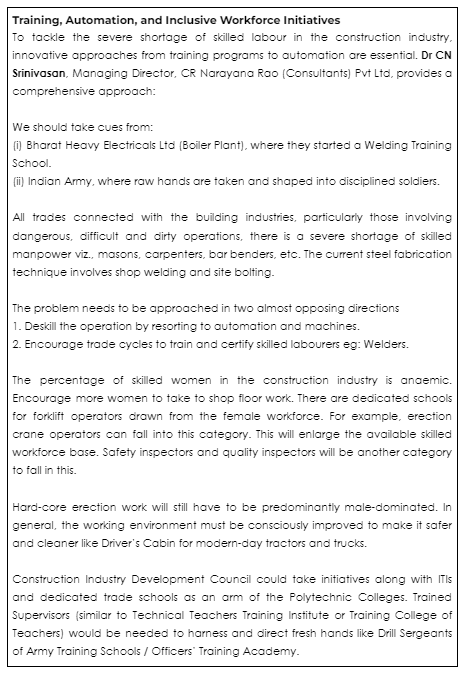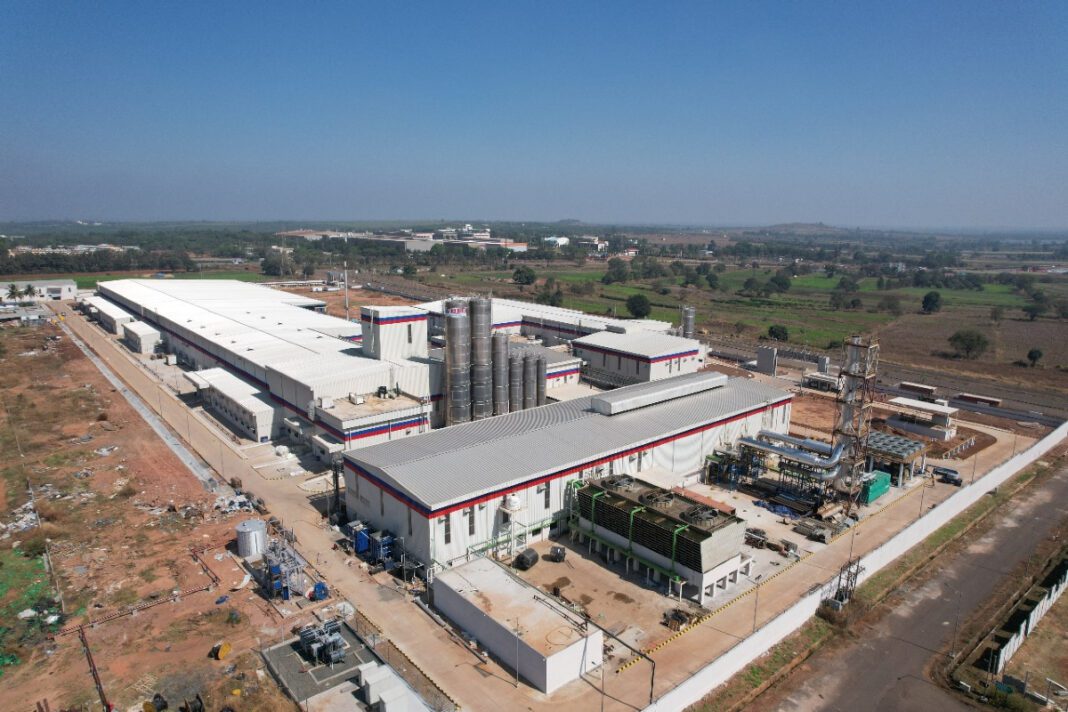India’s steel construction industry is on a meteoric rise, promising to reshape skylines and fuel the nation’s infrastructure development. Yet, a dark cloud hangs over this promising future: a critical shortage of skilled workers. This gap between industry needs and available talent threatens to stall progress and hinder the industry’s potential. To bridge this divide, a multi-pronged approach is urgently needed.
Experts delve into the root causes of the skill shortage, specifically limitations in current training institutes, and explore innovative solutions proposed by industry leaders. We’ll examine the industry’s call for a revamped educational system, the potential of automation, and strategies to create a more inclusive workforce.
Boom or Bust?
When asked why there seems to be a gap in retaining skilled workers in the industry, Rohan Lunkad, Executive Director, Rohan Builders, shares, “The steel construction industry is grappling with challenges in attracting new workforce due to perceptions of physically demanding, dirty, and unsafe working conditions. These perceptions discourage young talent from considering careers in steel construction.”
Prof LS Jayagopal, Managing Director, Mithran Structures, concurs, “Many construction sites, especially remote ones, lack basic amenities like decent housing, quality food, and clean water. This is a major turn-off for potential hires. The job often requires travel and frequent relocation, disrupting workers’ family lives. Long hours, unexpected delays, and periods of waiting due to other vendors add to the strain. The steel construction industry is known for its inherent dangers due to several unpredictable factors.”
Additionally, the industry’s cyclic nature, characterised by periods of high demand followed by downturns, also contributes to job instability, making it challenging to maintain a steady workforce.
Further adding to this list is that human error can contribute to accidents, highlighting the importance of proper training and focus on the job site. Steel erection often occurs in dynamic environments with changing conditions, increasing the risk of accidents. Construction projects are inherently fluid, with unforeseen situations arising. This necessitates constant safety protocols and risk assessments.
These factors combine to make falls from height, blows from falling objects, abrasions, and electrical shock some of the most common types of accidents faced by steel structure erection crews. This risk-prone environment pushes skilled workers towards less risk-demanding jobs in manufacturing or service industries.
Jayagopal further adds that skilled labourers are attracted to countries like Singapore, Malaysia, and the Middle East, which offer better working conditions, industry policies, and salaries. “Unlike other manufacturing sectors with steady work, steel construction suffers from inconsistent employment. Project delays, approvals, finances, and industry downturns can lead to long stretches without work.”
Amit Shah, Director, DCS Consultants highlights retention is a bigger challenge in India for various reasons, “The number of people who prefer structural steel as a subject is fairly limited. You don’t get the talent, and once you do, the onus is on you to retain them.”
He suggests, “One could be offering them a good learning opportunity. When freshers come to any organisation, they don’t have much knowledge. You need to groom them and make them good engineers so that they have a brighter future and get better opportunities outside. We often assume that the moment we train them, they will run away. Don’t assume that. There will be people who will stick around with you because they feel they still have many things to learn from your organisation.”
The second approach, he recommends, which everybody tries, is to offer a higher salary with an emphasis on environments that promote work-life balance. On the other hand, with senior employees, having crossed 10-15 years, the company could consider making them partners.
 Beyond Textbooks
Beyond Textbooks
This begs the question, in addition to traditional apprenticeships, what more can be done to develop the next generation while fostering a healthy environment? Lunkad suggests steel construction companies forge partnerships with technical institutions to develop tailored curricula aligned with industry needs.
India’s education system places a strong emphasis on theoretical aspects. Current civil engineering programmes often emphasise design and project management, with limited exposure to construction activities.
On the other hand, Shah shares, “The Indian education system is good, though it does have areas where it can improve. It already has a strong foundation, but where it is lacking, the education system can invite professionals to offer specific courses that are not part of the regular curriculum. These professionals can teach those specialised courses. If this is not sufficient, students can go to organisations where they will receive additional training.”
Jayagopal advices, “The fast-paced and ever-changing nature of steel construction demands a training approach that is both efficient and effective. Microlearning delivers information in short, focused modules, ideal for busy workers. This allows them to learn new skills or refresh existing knowledge quickly and easily. Microlearning can be tailored to address specific safety protocols, new technologies, or challenges encountered on the job site.” This ensures training is directly relevant to daily tasks. Relevant learning facilitates continuous skill development by allowing workers to learn at their own pace and on their own schedule. This keeps their skillsets current and adaptable to new industry demands.
 Lunkad adds, “To address this gap, India can draw lessons from Germany’s successful dual education system. This model integrates classroom learning with hands-on industry training, ensuring students acquire both theoretical knowledge and practical skills essential for the workplace.”
Lunkad adds, “To address this gap, India can draw lessons from Germany’s successful dual education system. This model integrates classroom learning with hands-on industry training, ensuring students acquire both theoretical knowledge and practical skills essential for the workplace.”
Implementing dual education systems that blend classroom instruction with hands-on training will prove highly effective. Integration of modern technologies like virtual reality for simulation training, alongside online and blended learning options, can enhance accessibility and engagement. Furthermore, establishing robust mentorship programs and industry-specific boot camps can offer practical experience and career guidance, bridging the gap between education and industry.
Shah emphasises that students must take responsibility for their learning. Engineers should actively engage with what professionals teach, rather than expecting to be spoon-fed. This proactive approach will help students enjoy the learning process and seize market opportunities.
To maintain morale, Jayagopal recommends, “By implementing programs that reward skill development, certification completion, and outstanding performance, companies significantly boost employee motivation. Celebrating successes fosters a culture of continuous improvement and commitment.”
He also states, “Sharing completed project timelines, videos, and photos with the team will give them a real-time look at the fabrication, erection process, and the amazing work everyone did. Encourage discussions about PEB steel building failures during erection, even in local languages. This will help us gain multiple perspectives on what went wrong and what preventative measures we can take to avoid similar issues in the future.”
Shah adds that twenty-five years ago, certain fields attracted little interest, but today, they are popular due to perceived opportunities. Similarly, civil engineering, which had limited prospects five years ago, now offers substantial opportunities. “We need many more civil engineers, and they will make good money. If that is the case, why not seize that opportunity? This demand is not going to decline for at least the next 20 years, until India becomes a developed country.”

Skilling up
To cultivate a long-term source of skilled workers for the steel sector, collaboration between industry, educational institutions, and government bodies is crucial.
Jayagopal recommends an advisory board composed of representatives from industry, academia, and government to foster comprehensive and inclusive discussions. This ensures that developed strategies address the needs of all stakeholders and consider diverse perspectives.
Educational institutions play one of the most pivotal roles. By integrating industry-specific skills into their curriculum, they can equip graduates with the necessary knowledge and skills to be job-ready upon entering the steel workforce.
Lunkad further adds, “As the Indian economy gears up for annual growth rates of 7-8 per cent, the steel construction industry is poised to expand significantly, intensifying the demand for skilled labour. Collaboration among industry, educational institutions, and government bodies is crucial to meet this growing demand. Industry involvement in curriculum development should ensure that education meets market requirements, while apprenticeships and internships can provide students with practical experience and direct pathways to employment.”
The Government can support this by highlighting the steel sector in career fairs and job creation programmes. Creating partnerships with educational institutions can help in introducing students to the steel industry early on, through internships, apprenticeships, and mentorship programs.
Additionally, government support through funding, grants, and tax incentives can incentivise businesses to invest in training programs. Joint R&D initiatives and innovation labs can drive technological advancements, exposing students to state-of-the-art practices such as AI-enabled machines, 3D modelling software, and construction monitoring drones.
 “Work is plentiful,” adds Shah, “as the government has created ample opportunities for civil engineers. With major events like the Olympics approaching, there are significant requirements set by state and central governments for development projects. If directives are not followed, the central government steps in to ensure progress. With these mega events and increasing construction projects already sanctioned, construction activities are set to rise.”
“Work is plentiful,” adds Shah, “as the government has created ample opportunities for civil engineers. With major events like the Olympics approaching, there are significant requirements set by state and central governments for development projects. If directives are not followed, the central government steps in to ensure progress. With these mega events and increasing construction projects already sanctioned, construction activities are set to rise.”
Jaygopal emphasises on the lack of dedicated training centres for the PEB industry workers. To address this, Indian PEB manufacturers can collaborate with educational institutions. “Together, they can establish a national-level association similar to the MBMA (Metal Building Manufacturers Association) in the US. This association could then create a comprehensive training and certification program. The program would cover various disciplines crucial to PEB construction, including: Fabrication, erection, sheet metal laying, insulation, quality auditing and corrosion protection.
The future of India’s steel construction industry hinges on its ability to bridge the skills gap. By embracing innovative training methods, fostering collaboration between stakeholders, and creating a more attractive work environment, the industry can cultivate a skilled and motivated workforce. This will not only ensure the continued growth of the steel sector but also empower India to build a stronger, more resilient infrastructure for generations to come.
Quote
“Industry involvement in curriculum development should ensure that education meets market requirements, while apprenticeships and internships can provide students with practical experience and direct pathways to employment.”
Rohan Lunkad, Executive Director, Rohan Builders
“Encourage discussions about PEB steel building failures during erection, even in local languages.”
Prof LS Jayagopal, Managing Director, Mithran Structures
“Encourage more women to take to shop floor work. There are dedicated schools for forklift operators drawn from the female workforce.”
Dr CN Srinivasan, Managing Director, CR Narayana Rao (Consultants) Pvt Ltd
“It already has a strong foundation, but where it is lacking, the education system can invite professionals to offer specific courses that are not part of the regular curriculum.”
Amit Shah, Director, DCS Consultants





